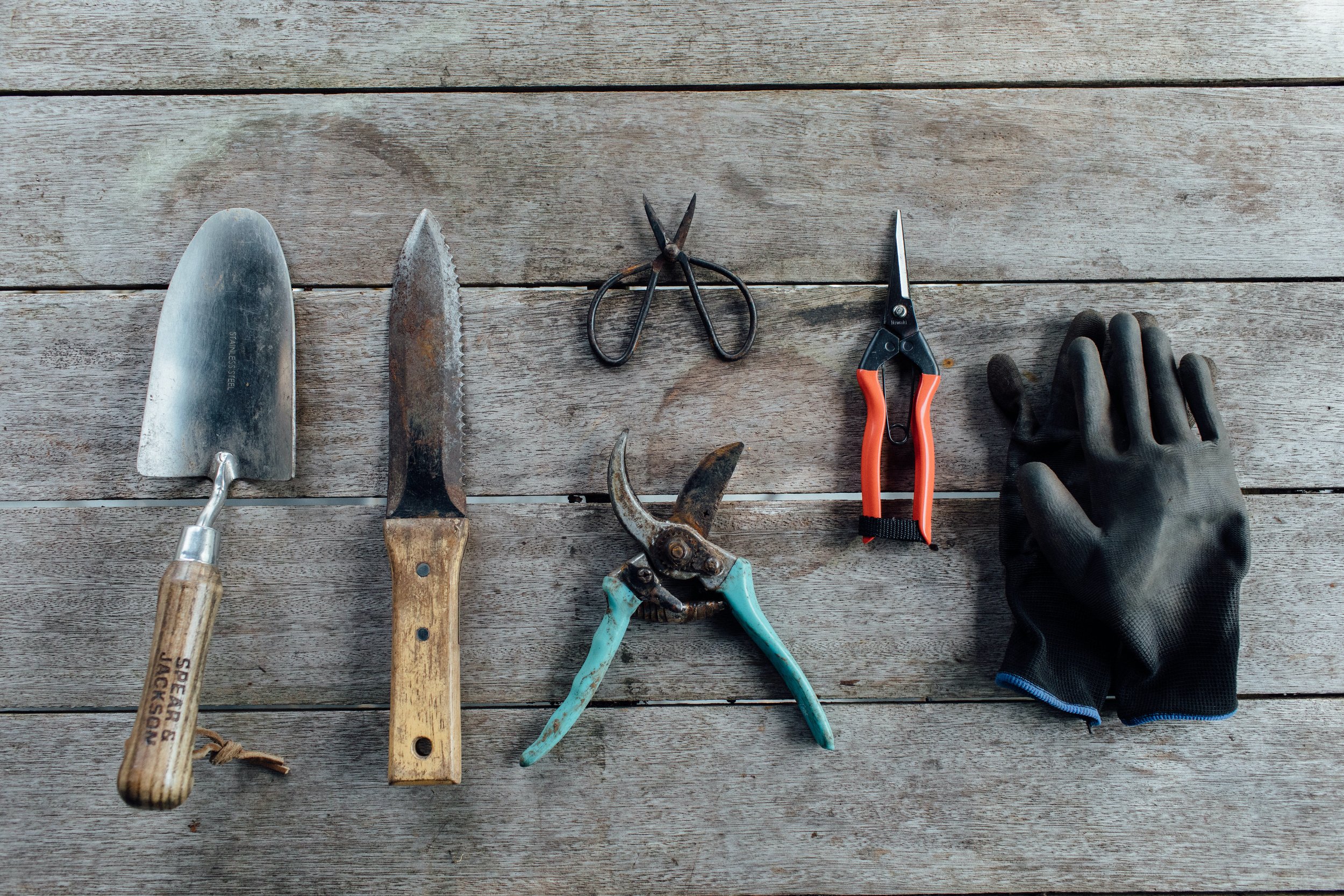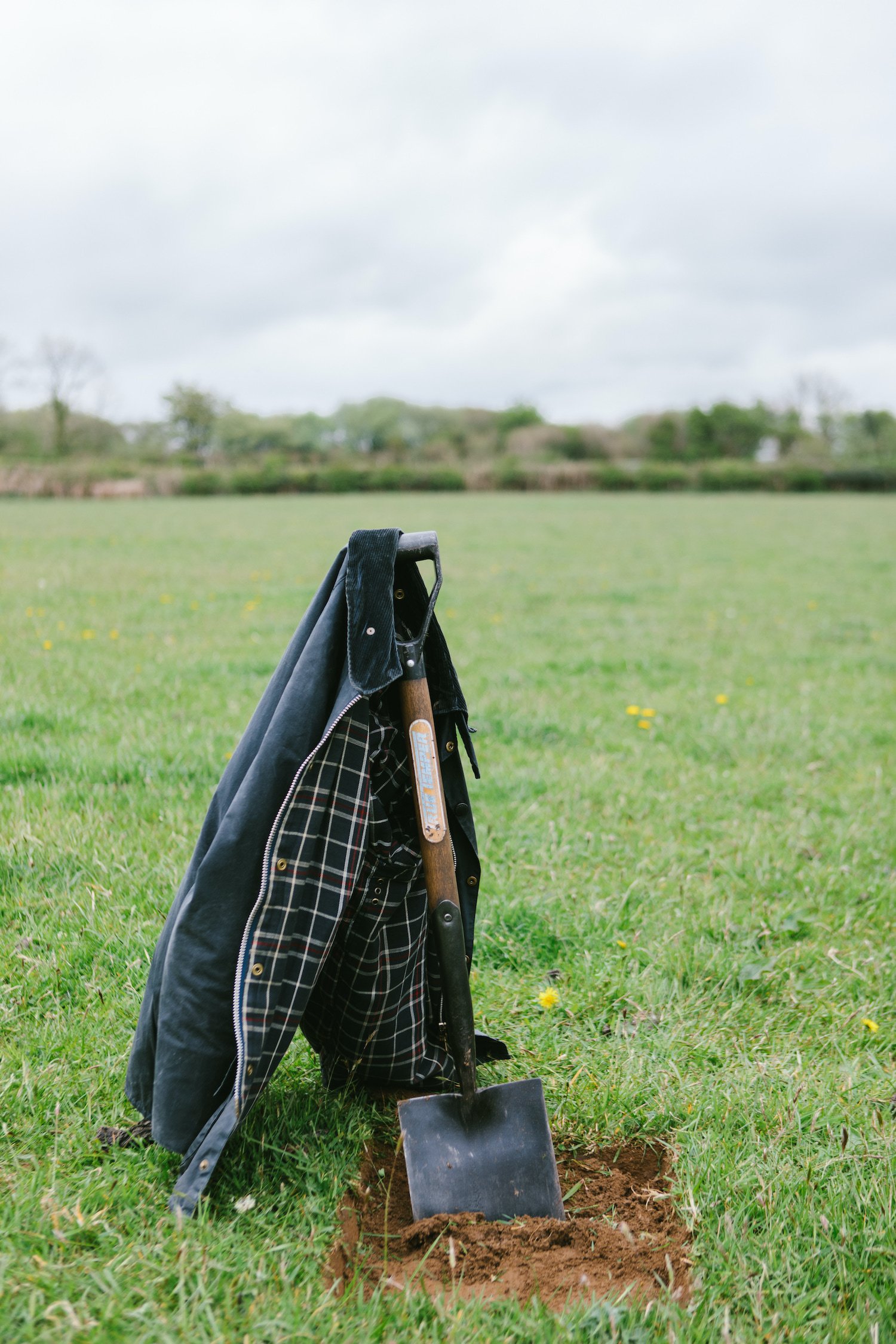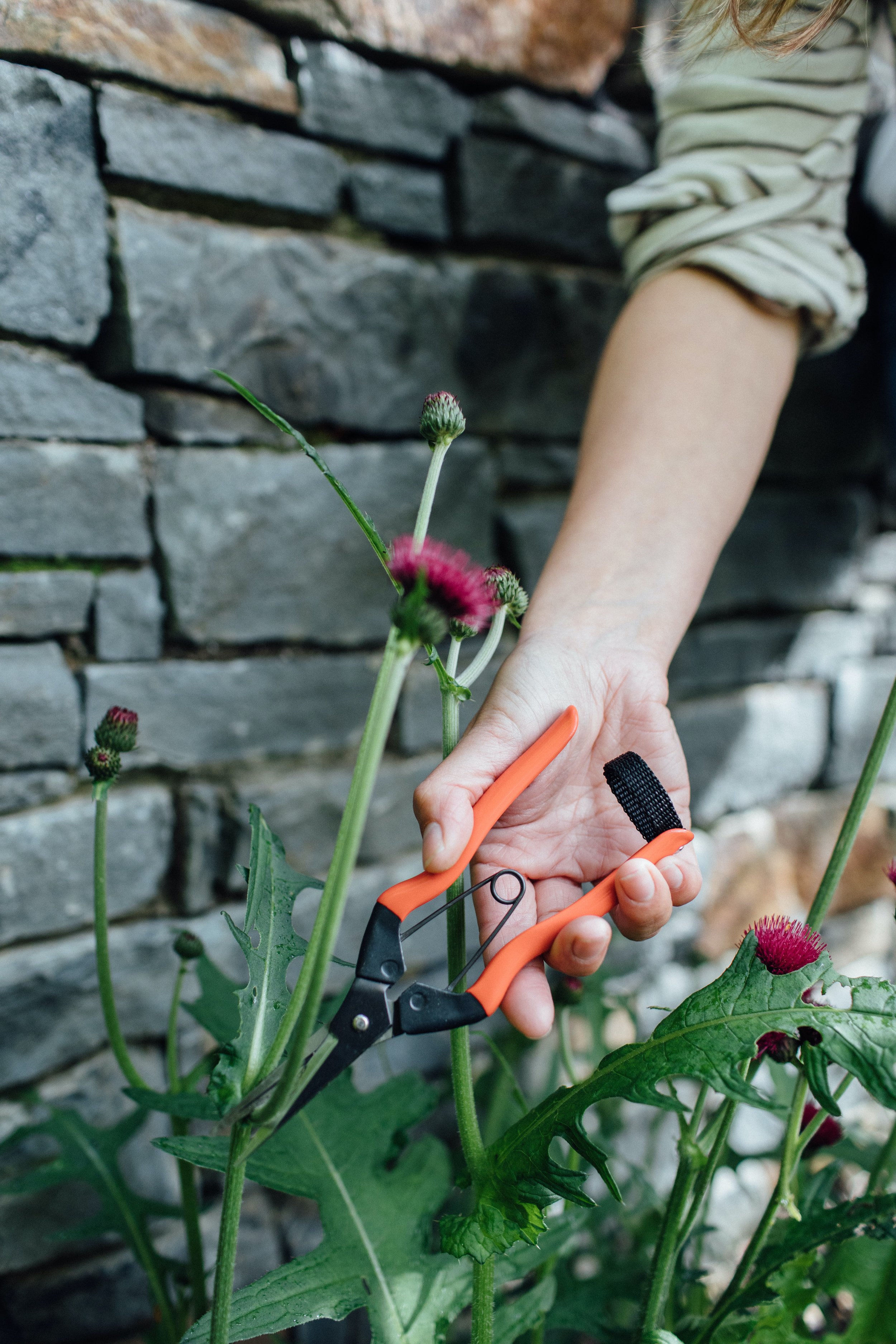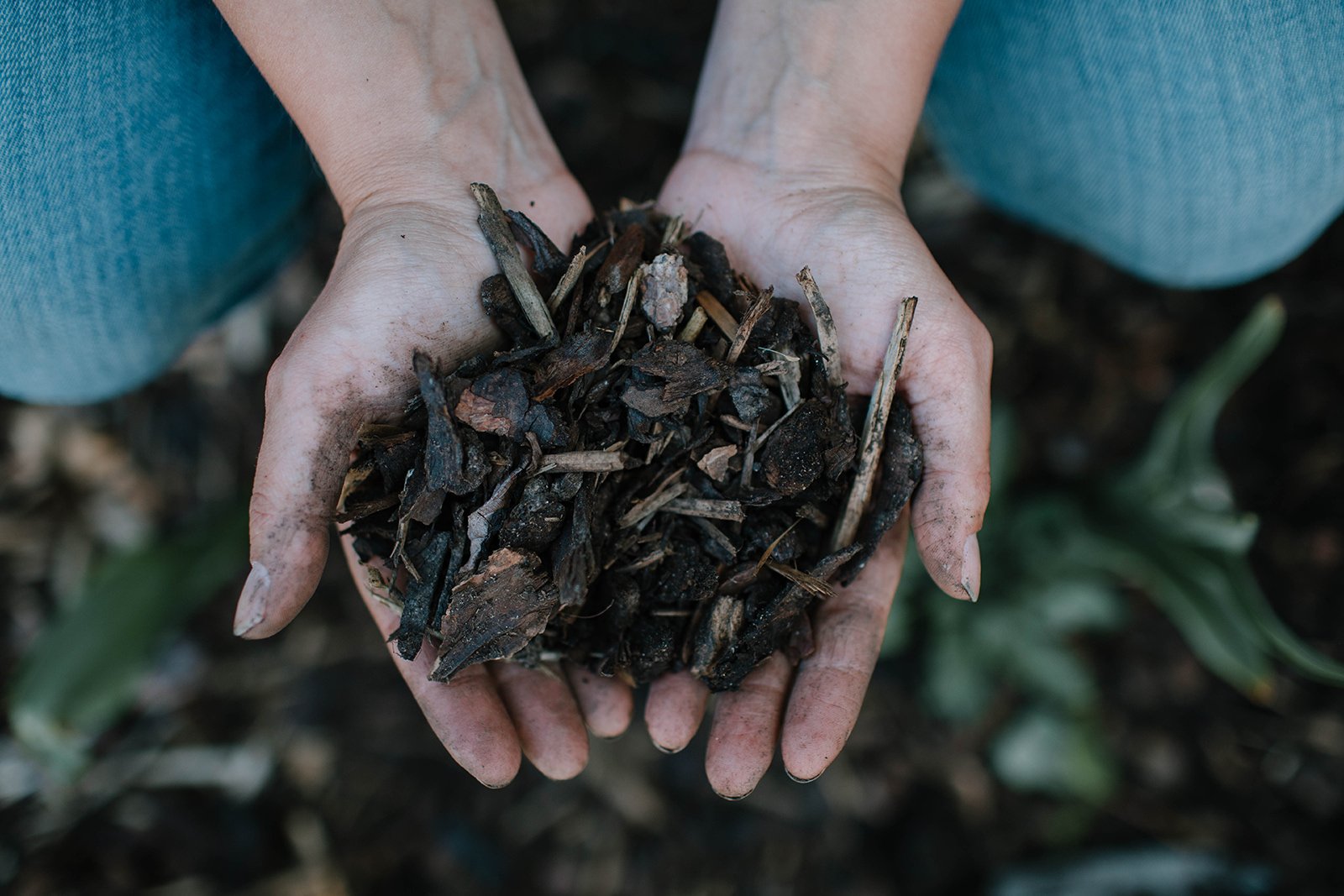Essential gardening tools
I am not a minimalist in many aspects of my life but I don't actually have that many gardening tools!
It's a bit like kitchen equipment; yes, you could buy the purpose-built egg poaching machine and then use a custom egg slicing tool to cut it with… But a good pan and knife would do exactly the same job, and many other besides.
It can be totally bamboozling in the garden centre with all of the different specialised tools available, and it’s very easy to get carried away and think you need an entire shed full of individual items for individual jobs. But a small collection of good quality tools that you really look after will serve you better than mountains of random garden gadgets you’re not really sure how to use.
When it comes to tools, it’s worth investing in good quality. This usually ends up being more cost effective in the long run. A solid, well-made tool will last for years (often a lifetime or more) whereas the cheapest ones available tend to have a short life span and are not easy to fix when they break. So unless you’re on a really tight budget, this is a time when it can really pay off to spend a bit more for better quality.
This is what is in our tool bucket:
A good pair of secateurs is an essential tool
Trowel
A good trowel is an essential for planting out and weeding. It’s an item that is probably going to get a lot of use, so needs to be sturdy. Our planting team have gone through a lot of trowels over the years! We have found that the most robust ones come with wooden handles. And take care with cheaper trowels as the handles can snap off easily.
Only use trowels in loose soil. If the soil is really hard, use a spade or mini spade first.
Trowels come in a huge different range of shapes and sizes, from those with pointed ends, to circular scoops. There is an element of personal preference about which you prefer, but a circular one tends to be better for scooping (great for putting compost into pots, for example) and a pointed one better for digging into the ground (useful when planting out, or digging out weed roots such as dandelions.)
Secateurs
Secateurs tend to be a gardener’s most used tool. They are used for cutting plant stems, both green and woody. A general guide is to use them on any plant material that is smaller in size than your thumb. (For anything bigger, use loppers – see below.)
Secateurs should always be kept sharp, so that they don’t damage the plant as they cut. (Hacking repeatedly at a branch to make a cut can squash and damage the surrounding parts that are left, and jagged, uneven cuts are more likely to get diseased.) Secateurs should produce a nice, clean cut in one go – only possible if they’re sharp enough and used on things the right size.
When it comes to which secateurs to choose, it’s really important that they fit your hands. Try them out in the shop first to see how they feel. Again, this is really personal and comes down to what size your hands are, and the way you move them. We have a pair of secateurs that Joe really likes to use, but I find that after a few cuts my hand is cramping and in agony!
A well-made (and usually more expensive) pair of secateurs can be serviced and fixed if needed, with many of the parts replaced if they age or get damaged. This is a time where choosing a reputable brand will really pay off in the long run, as you should be able to keep them for a lifetime.
My favourite pair are from Burgon & Ball. And plenty of gardeners swear by their trusty pair from Felco.
Keep secateurs clean by wiping them down after use. It’s a good idea to disinfect them regularly too (alcohol spray works well) in order to prevent any risk of spreading disease from one plant to another.
You can sharpen them yourself by using a sharpening stone, or send them off for a regular service, when they’ll be sharpened, lubricated and any parts tightened that need it.
Loppers
Loppers are used on anything you want to cut that is thicker than your thumb. They have longer handles than secateurs, which give them a more powerful cut, and also mean you can use them from further away. Again, the aim with loppers is to cut once only, to reduce damage to the plant.
As with secateurs, cheaper loppers tend to be less durable, and less easy to repair. However, since they usually get less use than a pair of secateurs, if you’re on a budget and need to choose one tool to spend a little more money on, then go for the secateurs every time.
Keep loppers clean by wiping down after use and sharpen when needed.
Weeding is just one of the many jobs you can do with a hori hori
Hori hori
AKA a Japanese gardening knife. This is one of the best multi-purpose tools ever, you could arguably ditch a trowel completely and just get a hori hori.
This has a sharp point and a “blade” on both sides, so it’s great for pushing into the ground even when it is hard. Especially good for planting bulbs, it’s also handy for weeding and can even be used to cut very soft green plant stems as well.
It is very sharp, though, and definitely not child friendly, so be careful where you leave it lying around.
Spade
Spades are useful for digging big holes. Often used if you’re planting trees or big shrubs, digging a pond, or working over a new bed before planting it.
The correct height of the spade makes a huge difference to how easy it is to use. If you’re shorter, then get a smaller one! There’s a lot of choice available now (tool companies seem to have finally wised up to the fact that not only men garden!) so it’s a great idea to pick up a few different sizes and try them. Make sure it is easy to lift as well – some spades are incredibly heavy and if you’re using them to shift soil, can become even more so. A final thing to check is the comfort of the grip – blisters and callouses aren’t uncommon after a while using a spade, so choose one that feels comfortable to hold to avoid this.
As with trowels, there are a variety of different shapes available – some better for digging holes, some better for shifting compost around, some even specialised just for edging a lawn! A “digging shovel” is a solid multi-purpose option.
Roughneck spade
We use these a lot, as they’re great for digging in a confined space. Sometimes called a “micro shovel”, they’re small, easy to carry and because they have a short handle are easy to use even in small spaces. We’ve found that they’re very handy for big pots as they’re compact enough for the space, but bigger than a trowel, which means you can get the job done quicker.
Floral snips
Floral snips are a bit like a pair of outdoor scissors, that you can use for deadheading and for picking flowers. I used to use secateurs for years, but discovering snips was a bit of a game changer! So much quicker and easier on your hands and the smaller size of the blade means it avoids crushing delicate stems at all.
You can get snips that look like secateurs, snips that look like scissors and snips that look like two small blades on a U. Take into account how safe they will be when not in use, especially if you have children. Some have safety catches to prevent them being opened and many others don’t…
Floral snips are handy for cutting flowers and deadheading
A small foldable saw
Pruning saws are used for anything that your loppers can’t handle. If the branch is too big for your loppers, then a pruning saw will be needed. These have sharp teeth and fold away inside the handle. They can feel a bit daunting to use for the first time and take slightly more patience and skill to use well.
If you don’t have any big shrubs or trees to tame then you won’t need this, or maybe not the loppers either, all herbaceous perennials and lots of smaller shrubs can be pruned using a good pair of secateurs.
However, if you have large woody plants from which you want to remove sizeable stems, then this would be a job for a saw.
As with most gardening equipment, there is a huge range on offer, so take into account how often you will be using it, what jobs you’ll be doing, and which ones feel comfortable in your hand. Look for safety features such as lock out mechanisms to avoid accidents, as this is a sharp piece of equipment.
Gloves
I don't get on with gardening gloves and really only wear them if I know I’m going to be dealing with thorns, cat poo, irritants or mulch. We use these electrician’s gloves, I wash them in the machine after a day’s work and they last for ages. I have pairs of them everywhere, so it’s always easy to grab a pair when I need one…
I also use gauntlet gloves (which I call my falconry gloves!) which are great for brambles.
Like so much with gardening, it’s a matter of personal preference, but part of the enjoyment of gardening for me is actually feeling the things you’re working with: a soft leaf, dew-covered grass, crumbling soil. (Interestingly, there has been research that shows putting your hands in the garden beds can release microbes from the soil that cause serotonin production; in other words, getting your hands dirty gardening can literally make you happier and more relaxed!)
However, there are also toxic substances to be avoided, and sharp spikes or prickles that can hurt without gloves. I always wear them if I know there is (or might be) cat poo around, and this is especially important for pregnant women because of the risk of toxoplasmosis. Mulch and compost can be a risk for tetanus or legionnaire’s disease, so it’s wise to wear gloves to handle this. And roses, brambles and even weeds like nettles or green alkanet can graze, cut or sting you without adequate protection.
Gardening gloves need to be comfortable and to move with your hand. Try a few pairs and see what feels good, though remember that some thick gloves, such as leather ones, will soften with age.
Flexi trug
The perfect piece of carrying equipment for almost anything in the garden! We have several of these and use them for a huge range of different jobs: carrying tools, collecting weeds, as a bucket to soak a dry looking pot. Because they’re flexible, it’s easy to pull the handles together to carry them around, but they have much more space inside than a normal bucket.
You do need space to store them, as they’re plastic and not hugely attractive, so don’t look great if you leave them lying around. And if you do store them outside, remember to turn them upside down first, or they fill up quickly in the rain! The main downside is that they’re made of plastic, and if you want to avoid that, you could try rubber feed tubs instead, which do a similar job but are significantly heavier.
Hose
Not all hoses are created equal! Searching for the perfect garden hose can feel like an impossible quest at times. It’s really hard (perhaps impossible?) to find one that looks good, does the job well, stores out of the way easily and cleanly, but is accessible when it’s needed.
We always use Hoselock hoses. They’re not particularly attractive, but work well. If you’ve got a small garden and the hose will always be in view, then Garden Glory hoses are beautiful (though you will still need to wind it away manually each day…)
Extra parts that we find indispensable are an adjustable spray attachment and a lance. This is handy for pots, especially hanging pots, green walls and other tricky-to-reach spots. It makes it easy to water the base of your plants, rather than spraying all over the leaves.
Watering can
Which watering can you choose will depend on where you store it. If it needs to stay outside, then you might want to opt for a more attractive one: Haws have a range of really attractive watering cans, both metal and plastic, though the prices for some of the high-end ones are quite, well, high end!
Galvanised watering cans are beautiful, though they can rust. You can sometimes find old ones second hand for a bargain, and if it’s still in good condition, this is a good sign it should keep doing well…
I have a good quality heavy-duty plastic one, which I use for everything, and rarely add a rose on the top.
Make sure you can lift the watering can when it’s full. Though it can be tempting to get a really big one (to reduce the amount of time you need to re-fill it) this makes it much heavier, and easier to spill as well.
It is useful to have a smaller watering can for seedlings, or small plug plants, so they’re not deluged with water (and these often double up for houseplants too). I have a nice Haws small one, which I use for these jobs.
Beware of really thin, cheap plastic watering cans, which can seem like a great bargain, but spring holes very quickly.










